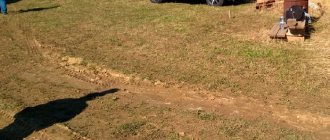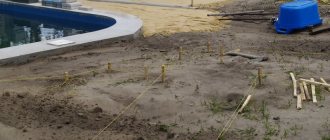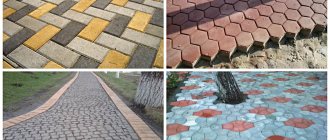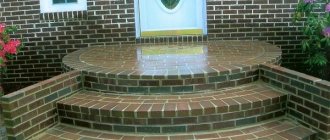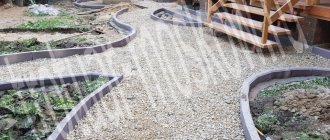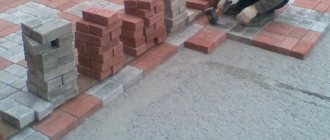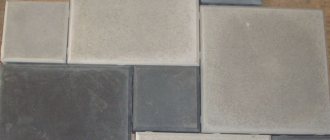White coating is characteristic of all types of concrete pavement. Its presence on newly installed pavers can be frustrating for homeowners. For them, the usual statement, “I can’t take responsibility,” “will disappear over time,” is not a consolation but a way to wash their hands in the end.
Frankly, manufacturers are stuck between a rock and a hard place. No matter how hard they try, there is little they can do to control efflorescence. What is available is usually already used by many of the best manufacturers. It is in their own interest to try to minimize the occurrence of efflorescence. But even if they used every known trick, efflorescence-reducing additive, or any other strategy, they still couldn't guarantee that fading wouldn't be a problem for their products. This is a natural problem. The chemistry is complex and involves a number of factors over which neither the manufacturer, contractor nor homeowner has any control.
So: What can you do to reduce the visual impact of efflorescence or speed up its resolution? There is a lot of advice out there, many of which are dubious and some of which are downright dangerous. But there are a few tried and tested "tips" that are worth trying, even if they don't completely solve the problem.
What is efflorescence?
The appearance of white spots means different things to different people. For manufacturers, this is an insurmountable problem; to the contractor - this is something else that the customer can blame on him; to a homeowner it is a whitish hue that may appear similar to powder or soap scum visible in dirty bath water, while to a chemist it is most easily described as calcium carbonate with smaller amounts of other carbonates, sulfates and chlorides. Salts The bulk of the efflorescence observed in concrete pavers is calcium carbonate, while for clay pavers the main component is usually sodium chloride - table salt - along with sulfates and some carbonates. The remainder of this section focuses on calcium carbonate efflorescence observed on concrete products, as this is the most common form.
Simply put, calcium carbonate is a byproduct resulting from the interaction between the cement used to make pavements and the environment, including the soil, weather and atmosphere. As a result, plaque or “salt” appears on the surface of the road surface. There is no unambiguous appearance - sometimes it is powdery, sometimes dull, sometimes cloudy and fuzzy; sometimes it is harsh, obvious and clear.
Sometimes it covers large areas, sometimes it affects individual units, and sometimes it affects half or two-thirds of the area. Salt seems to affect dark road surfaces more than lighter ones, but the truth is that it is simply more noticeable against a dark background.
However, it is always white, although it can be gray-white or white-blue, and always spoils the appearance and color of the road surface. It may seem to disappear when the pavement is wet - this is because the water temporarily clears the salt rather than removing it. After the surface dries, efflorescence usually appears again.
How to remove efflorescence on tiles
A pattern unique in its beauty and design can be created using paving slabs. This coating will fit very harmoniously into the surrounding landscape and will please the eye for a long time.
However, with the arrival of spring, the bright pattern fades, and in some places white spots and stains may form on the paving slabs. This is efflorescence.
White spots and stains may form on the tiles in some places - this is efflorescence.
Let's start by taking a closer look at what efflorescence is. Concrete gains 100% of its strength within 28 days after mixing. Until this point, there is still free calcium in the concrete structure, which can interact with water. When produced using vibropressing technology, paving slabs are removed from the curing chambers when they reach 80% strength.
At this point, free calcium can react with water (rain, snow, condensation), resulting in the formation of calcium hydroxide Ca(OH) on the surface of the tile. Which in turn, upon reacting with carbon dioxide, crystallizes, which leads to the formation of calcium carbonate salt CaCo3, also known as efflorescence, on the surface of the tile.
By their nature, they are “primary”, formed during the process of hardening and strengthening of concrete, and “secondary”, the occurrence of which is possible during the operation of tiles that have gained strength and are laid. In both cases, an indispensable condition for the appearance of a white coating is alternate wetting and drying of the concrete.
If the paving slabs have not experienced alternate wetting and drying before they are laid, then, as a rule, no primary efflorescence will appear on the surface. Already during operation, secondary ones may appear, the likelihood of which depends not only on the properties of the tile itself, but also on the conditions of its operation, for example, the use of reagents and salt in winter. Next, we will learn how to clean paving slabs from white deposits, how to get rid of efflorescence on paving stones, and what prevention is most effective.
How to get rid of efflorescence on paving slabs?
Currently, there are many special cleaning solutions that will help get rid of the problem. You should pay special attention: the earlier you notice the appearance of whitish spots, the higher the likelihood that you can easily get rid of them.
Therefore, there are:
- gentle products that are intended for early stage salt deposits;
- strong products that contain a high concentration of chemical components that can fight old efflorescence.
On sale you can find concentrated liquids that need to be diluted with water, and those that are immediately ready for use.
In both cases, the tile surface treatment technology has the following sequence:
- Before removing salt from the paving stones, you need to clean it of dirt and debris and remove the sand with a brush.
- It is worth remembering that to clean the tiles you will use a fairly aggressive chemical composition, so before preparing the solution (if you are using a concentrated product) and while applying the composition to the tiles, be sure to use safety glasses and rubber gloves.
- If you purchased a concentrated product, you must dilute it with water in accordance with the proportions specified in the instructions for use.
- The solution must be poured into a paint tray and applied to the surface of the tile with a paint brush or roller, evenly distributing it over the entire surface of the tile, avoiding smudges or accumulation of liquid in one place.
- After applying the solution to the paving slabs, it must be left for the time specified in the instructions for use.
- After the time specified in the instructions has passed, the applied solution is washed off with water using a brush or damp cloth. It is also possible to wash off the solution from the surface of the paving slabs with a stream of water under a pressure of 100 bar.
- At the end, the paving slabs must be completely dry, which is why such work should be carried out in warm, clear weather.
If the salt deposit was not completely removed as a result of treatment, the treatment process is repeated.
It is possible to completely prevent the re-formation of efflorescence on an already laid coating only by eliminating the contact of atmospheric precipitation and melt water. However, on the street, in most cases, this is not possible.
The presence of efflorescence on the tiles or their subsequent appearance during operation is not an indicator of defects or the use of low-quality raw materials by the manufacturer. This is confirmed by GOST 17608 clause 4.6.4.
How to prevent efflorescence?
The most effective measure to prevent salt deposits is volumetric or surface hydrophobization of paving slabs. It can be done at any time during or after the production of concrete products. The use of such additives greatly reduces the level of water absorption of concrete and practically blocks efflorescence.
It is worth paying special attention that before applying a water-repellent solution to paving slabs, preliminary preparation of the surface is necessary, which includes the complete removal of efflorescence, dirt and sand from the surface of the tile.
The process of surface hydrophobization includes several stages:
- After you have prepared the paving slabs for processing, immediately before preparing the solution (if you are using a concentrated product) and while applying the composition to the tiles, be sure to use safety glasses and rubber gloves.
- If you use a concentrated solution, you must dilute it with water in the ratio specified in the instructions for use.
- The prepared solution must be poured into a paint bath and applied with a brush or roller, generously wetting the surface of the paving slabs. To treat large areas, it is allowed to use machine-type sprayers and spray guns.
- After treatment, the paving slabs must dry completely. The waterproof effect of the tiles will occur within 24 hours after applying the solution.
IMPORTANT: no matter what paving stones you choose, be sure to prepare a high-quality base taking into account the characteristics of your site: type of soil, height of groundwater, depth of soil freezing. Armed with this knowledge and installation instructions, you'll get great results. Remember: the best paving stones are not a 100% guarantee of the durability of your paving; the quality of the entire complex is important here.
At the same time, it should be especially noted that the presence of efflorescence on the tiles or their subsequent appearance during operation is not an indicator of defects or the use of low-quality raw materials by the manufacturer. This is confirmed by GOST 17608 clause 4.6.4. Efflorescence can rather be attributed to a chemical reaction inherent in the very nature of concrete when interacting with water.
The chemical effect of salt on paving slabs
Concrete is made using cement and cement is made from limestone. Consequently, all concrete surfaces contain some amount of lime or calcium oxide (CaO), which gives it its "resurrection". Higher quality paving materials are made from higher quality concrete, which typically has a higher cement content compared to "budget" products, and so, conversely, efflorescence can affect higher quality products more severely than "budget" alternatives. Some manufacturers try to get around this by replacing some of the cement with alternatives such as ground fly ash (PFA), which "sets" the same as cement but contains little or no lime. However, PFA is difficult to dye so while its use may reduce the problem of efflorescence, it may increase production costs due to the higher levels of dyes required.
Calcium oxide is soluble in water.
It dissolves to form calcium hydroxide
This soluble calcium hydroxide can migrate to the pavement surface, after which it has the opportunity to react with carbon dioxide (CO2) in the atmosphere to form insoluble calcium carbonate and a small amount of water.
So: this carbonation of calcium hydroxide causes insoluble calcium carbonate to fall onto the surface of the road surface, and the water simply evaporates. It is this calcium carbonate that forms the white coating that is the most visible indicator of ongoing fading.
Although calcium carbonate is insoluble in water, it is unstable and gradually reacts with more carbon dioxide and more water to form calcium bicarbonate, better known as calcium bicarbonate, which is soluble.
The problem is that this transition from insoluble to soluble occurs more slowly than the previous transition from soluble to insoluble, so there is a "buildup" of excess insoluble material, which is a white precipitate visible on the surface.
Primary flowering:
As the concrete hardens, some of the water in the mixture reacts with the cement to form calcium hydroxide, which, being water-soluble, can be transferred to the surface of the pavers during the curing process, and when the water evaporates, the calcium hydroxide remains.
Because curing concrete is a long, drawn-out affair that continues for weeks or months (long after the concrete itself appears to have "set"), the chemical production of calcium hydroxide continues, although it "dies down" as more part of the original calcium oxide is hydrated. This phenomenon is known as primary fading, defined as fading that occurs as a by-product of the manufacturing process. It usually (but not always) appears fairly evenly over the entire surface of the affected paving stones.
Secondary flowering:
Because many paving slabs have a relatively short turnaround time (from fresh plastic concrete at the plant to installation on site, it can take as little as a week!), curing will continue after the pavement has been laid and as it is now exposed to the environment. Because of the atmosphere and rain, calcium hydroxide molecules deep within the paving structure have more opportunity to dissolve and be transported to the surface.
This is secondary fading, different from production. Since the occurrence and movement of this “secondary” water is very random, depending on the time of year, location of the site, parking, shelter from neighboring buildings, proximity to open areas and a number of other factors. Secondary fading usually (but not always) has a more random appearance, as it affects some blocks more than others and some not.
How to effectively and quickly remove efflorescence on paving slabs
Submit your request
Call back Send request
A real masterpiece can be created using paving slabs, especially if you use a variety of shades for a mosaic pattern. Firstly, such a coating will delight you with its aesthetic appearance, and secondly, it will harmoniously fit into the surrounding landscape.
But with the arrival of spring, after the snow melts, this beauty suddenly becomes faded, and in some places a white coating is noticeable. This happens often, and this is not due to precipitation, in which reactive and acidic elements can be found, but to the quality of the tile itself. Therefore, before purchasing products for covering yards, sidewalks, and playgrounds, you should consult about the components in the product.
If you still cannot avoid purchasing a low-quality product, you can use special means to prevent the appearance of mineral salts on the surface or use proven methods to eliminate them.
What harm do efflorescences cause?
Efflorescence is a white deposit resembling lime or chalk. They are formed from mineral salts, which are contained in the constituent components of paving slabs.
The chemical composition of these formations sometimes differs. To a greater extent, there is a mixture of sodium, sulfate, carbonate and potassium, which, when evaporated, has a detrimental effect not only on human health, but also destroys the coating itself. Many of these substances do not dissolve, so they cannot be washed off with plain water.
Efflorescences that are mixed with third-party chemical compounds are considered more aggressive. These may be harmful emissions from nearby plants and factories, carrying particles of heavy metals and various acids. As a result, the tiles deteriorate very quickly, and their structure loses its strength and aesthetic appearance.
Sediments tend to disappear on their own by weathering or washing by heavy rains, but this may take several years, and during this time the coating will lose its appearance.
Causes of efflorescence on paving slabs
Salt formations can occur for many reasons. The main one is the low quality of products, which do not comply with standard standards. Some manufacturers add various additives to the solution of future tiles for strength during production.
Most often, paving slabs are stored in plastic packaging, which contributes to the appearance of unwanted stains, as well as condensation, which can penetrate deep into the material and subsequently cause mineral salts to be pushed out.
How does white plaque disappear from paving slabs?
As mentioned in the chemistry lesson above, the white residue gradually turns into a soluble compound that is simply washed away by the weather and/or a hose. However, there are other factors that reduce or eliminate the visual impact of efflorescence.
Blocked capillaries:
The tiny pores and voids in the concrete matrix through which soluble calcium hydroxide is transported eventually become clogged with deposits of insoluble calcium carbonate. This effectively blocks the calcium hydroxide's escape route and "blocks" any further reactions, causing them to occur below the surface and, conveniently for us, out of sight.
Abrasion:
Simply walking on the sidewalk will abrade the deposits, wearing them away and reducing the amount visible on the surface.
Weathering:
While we know that rain can dissolve and wash away soluble efflorescence products, it can also wash away some of the insoluble material, just as sand or other debris can be washed away from a surface. Other weather events such as wind, snow, hail, etc. can also speed up the removal of both soluble and insoluble substances. Slightly acidic rain dissolves settled salts better, so the problem may disappear sooner in urban areas than in rural areas.
Instructions for removing efflorescence: how and with what to effectively remove white deposits from paving slabs?
Efflorescence
- This is a deposit on the surface of the tile, which is a by-product of concrete hardening. Efflorescence is not a defect in accordance with GOST for paving slabs, but can visually spoil the appearance of the paving.
We talked in detail about what efflorescence is and why it occurs here, and below we will tell you how to get rid of it.
As a rule, efflorescence disappears without the use of cleaners, but you will need to wait from 3 to 12 months.
If the salt deposit has formed significantly or you want to get rid of efflorescence immediately, then there are effective means to combat salt on the surface of the tiles.
Before you start purchasing the product, it is important to understand that efflorescence on concrete paving slabs is of carbonate-sulfate origin.
Ca(OH)2 + CO2 = CaCO3 + H2O.
As a result of a chemical reaction, calcium carbonate CaCO3 crystallizes on the surface of the paving slabs in the form of a white salt coating.
To clean salts of this origin, choose acid-based products. Acidic agents effectively dissolve salts of carbonate and sulfate origin.
Efflorescence on paving slabs Old Town
How long it will be going on?
This is not an easy question. No one can say how long any efflorescence will last. This could be several weeks; it could be a couple or three months; it could be a year or two. There are so many factors that influence its appearance, appearance and disappearance that an educated guess is the best we can do.
Please note: How to choose a border for paving slabs?
We know that certain conditions have an effect: damp, shady areas can be more adversely affected than open, sunny areas, and for some reason this phenomenon always seems to be worse, which must be related to climate and soil conditions. Somehow, but no one knows how exactly.
However, this response does little to assuage the homeowner's concerns. They spent a ton of money on a sidewalk or driveway and it looks, frankly, pretty damn terrible. In most cases, efflorescence becomes noticeable 3-6 weeks after installation is completed and then lasts 3-6 months before gradually fading over 3-6 months. Most people never seem to notice it's there. He just “appeared” overnight - and most do not notice his departure.
Is it possible to wash it off faster?
Obviously, manufacturers and suppliers of various miracle cures have a vested interest in declaring their cocktail to be the best, fastest and most effective, but how can this be proven with something so apparently random? There is no doubt that some of the patented products do remove visible salts from the pavement surface, but this is a temporary solution - the problem is very, very likely to return.
Remover
Any “chemical” treatment must be very carefully considered and tested on an inconspicuous area before applying it to the rest of the pavement. Many of these products are based on a mixture of detergents and acids that "eat" or "dissolve" the insoluble carbonate and allow them to be washed away. However, some acids can also react negatively with the pigments used to color concrete and can cause alarming color changes.
Additionally, they can actually make the problem worse by loosening clogged capillaries and micropores, which then allows calcium hydroxide to come to the surface again. While stone products are generally not susceptible to fading, they may be used in conjunction with or near areas of concrete or clay, and acid-based products may cause severe discoloration or damage to the stone.
A non-chemical strategy includes regular brushing and rinsing with clean water. This helps remove both soluble and insoluble efflorescence products and can actually speed up the eventual disappearance of the deposits. There have been suggestions that a few drops of dishwashing liquid added to each bucket of water may also help.
As more and more of us get pressure washers, they are increasingly used in the fight against efflorescence, but it is unclear whether they help or hinder. There is no doubt that they can and do remove some deposits, but they can also damage the pavement surface, especially if used regularly on wet slabs, and it is suspected that the powerful jet of water may open up the pores. Their use is probably worth considering once or twice a season when deposits are large as they can make a significant improvement, although temporary, but regular use is detrimental.
How to avoid efflorescence?
Manufacturers
The homeowner is powerless. There is nothing they can do to influence whether efflorescence becomes a problem or not. They are limited to solving the problem if and when it arises. However, manufacturers and installation contractors can take steps to minimize the possibility of problems occurring, but they cannot be completely eliminated. Manufacturers have the greatest influence as there are many opportunities to intervene and manage the production process to minimize potential problems.
They can…
- Reduce the amount of water used in the concrete mixture and thus minimize the possibility of migration of calcium hydroxide during the initial curing process.
- Use admixtures that act in fresh concrete to minimize the formation of salts.
- Control the curing process by adjusting temperature and humidity levels in the curing chamber.
- Slow down the curing process to encourage the formation of insoluble calcium carbonate in the pavement and thereby create an internal barrier to the migration of dissolved salts.
- Monitor the packaging to ensure the pavement is “wet” during the first week or so of the curing process.
- Monitor pre-storage to ensure optimal conditions that minimize the formation of excessive condensation, which returns water to the pavement and thereby promotes migration. This is mainly achieved by keeping newly manufactured units in a dry and well-ventilated but draft-free area, where condensation is removed before it is released back onto the road surface.
Many of the best manufacturers employ some or all of these strategies, as well as their own "secret" techniques. When products develop a reputation for high levels of efflorescence, they tend to not sell and cause more consumer complaints and negative feedback for the manufacturer. Product sellers are on the front line of supply and often bear the brunt of customer ire.
Thus, if a particular product or manufacturer is perceived to be prone to efflorescence problems, sellers are less likely to adhere to those positions. In general, the manufacturer has an interest in doing everything practically or economically possible to minimize the problem, but, as has been said many times, they cannot be expected to prevent it entirely.
Contractors
Contractors have less influence, but there are steps you can take to reduce the likelihood of problems occurring. The most important of which is the choice of material for laying the path. Mortar, concrete, and other cementitious substrates can introduce calcium hydroxide into the system, and this additional material can be carried into and through the paving units by the capillarity of water to the surface through capillarity and evaporation. This can be a serious problem in damp or damp areas.
Where a cement layer is required, the risk of efflorescence can be minimized by using as little cement as possible and using as dry a mixture as possible. Two common misconceptions that are common when building patios are the belief that a “strong” bedding mixture is required and that the bedding must be damp for it to adhere to the flags. On such projects, only the litter needs to be stabilized; that is, cement is needed only to bind the installation material together and prevent it from being loosened and removed by groundwater, invertebrates, or human trafficking. It doesn't have to be as hard as iron—a 10:1 mix ratio is usually more than enough for deck construction.
Likewise, there is no particular need to “glue” the flags to the bedding. A properly designed base will provide level, uniform support for the entire flag, with the entire base of the flag in contact with the base, creating significant "friction" between the flag and the base. This factor, combined with the "locking" provided by adjacent flags, is usually sufficient to resist lateral (lateral) movement of the flags, although flags laid on free edges may need some additional restraint.
Another way a contractor can unintentionally contribute to efflorescence problems is by using frost-resistant or accelerators in bedding and/or joint materials. Many of these products are based on calcium chloride solution, which is another source of calcium hydroxide. It contains chloride ions, which can form additional salts on the surface.
Reasons for the formation of salt deposits
The appearance of white spots is due to the presence of mineral salts in the building materials and water from which the FEM was made. Another reason for the occurrence of efflorescence on paving stones is a violation of the rules for storing paving slabs. High humidity in the warehouse and improper packaging of materials can lead to the slabs becoming saturated with water and the formation of salt stains after they dry.
The chemical composition of protruding spots on paving slabs can be different, but most often the main components are calcium and magnesium salts, various sulfates and carbonates. These substances not only spoil the appearance of the tile covering, but also actively contribute to its premature destruction.
The most aggressive effect on the FEM material is caused by efflorescence mixed with chemicals from atmospheric air and precipitation. This could be harmful emissions from nearby industrial plants or runoff from roadways. They contain acidic solutions and particles of heavy metals, which actively contribute to discoloration and destruction.
Most of the chemicals in the white coating are insoluble in water and therefore their spontaneous disappearance as a result of exposure to rainwater and weathering can take several years. Therefore, the appearance of efflorescence on the paving slabs will require the owner of the site to decide how to wash the salt from the paving slabs until it is completely eliminated.
In most cases, active staining is the result of a violation of production technology.
The appearance of salt deposits on the surface of the slabs after their laying can be designated as a violation of the manufacturing technology as a result of lack of quality control of the raw materials, water composition and concrete compaction. To avoid purchasing substandard goods, you need to carefully inspect the tiles and at least determine its moisture content by touch.
Efflorescence on paving slabs - a defect or not? We can say that in 90% of cases this is a manufacturer's defect. Therefore, if you find wet slabs or visible defects on several copies, it is better to refuse to purchase the entire batch. Paving slabs should be dense, low-porous and dry to the touch.

